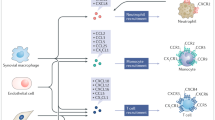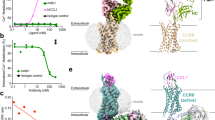Key Points
-
Chemokine receptors are attractive therapeutic targets for inflammatory and autoimmune diseases.
-
It is likely that chemokine receptors could be effectively targeted using small molecule inhibitors.
-
Drugs targeting various chemokine receptors have been approved for non-inflammatory conditions, but so far there are no such drugs for autoimmune or inflammatory disease.
-
The current lack of successful drugs targeting chemokine receptors in autoimmune and inflammatory diseases should not be attributed to the so-called 'redundancy' of the chemokine system.
-
Successful chemokine receptor-based drugs will be enabled by understanding that target selection and sufficient receptor coverage are crucial for therapeutic efficacy.
-
Clinical trials designed according to these principles will establish the validity of therapeutic interventions that inhibit this receptor class.
Abstract
Chemokines and their receptors are central to the inflammatory process and are attractive therapeutic targets. Drugs that inhibit chemokine receptors are approved for the treatment of HIV infection and for stem cell mobilization, but none have been approved yet for the treatment of inflammatory and/or autoimmune diseases. We analyse the challenges of developing chemokine receptor antagonists, and propose that inappropriate target selection and ineffective dosing, not the 'redundancy' of the chemokine system, are the main barriers to their use as anti-inflammatory therapies. We highlight evidence suggesting that chemokine receptor inhibition will prove to be an effective therapy in inflammatory diseases.
This is a preview of subscription content, access via your institution
Access options
Subscribe to this journal
Receive 12 print issues and online access
$209.00 per year
only $17.42 per issue
Buy this article
- Purchase on Springer Link
- Instant access to full article PDF
Prices may be subject to local taxes which are calculated during checkout



Similar content being viewed by others
References
Murphy, P. M. et al. International union of pharmacology. XXII. Nomenclature for chemokine receptors. Pharmacol. Rev. 52, 145–176 (2000).
Zlotnik, A., Yoshie, O. & Nomiyama, H. The chemokine and chemokine receptor superfamilies and their molecular evolution. Genome Biol. 7, 243 (2006).
Sallusto, F. & Baggiolini, M. Chemokines and leukocyte traffic. Nature Immunol. 9, 949–952 (2008).
Gerard, C. & Rollins, B. J. Chemokines and disease. Nature Immunol. 2, 108–115 (2001).
Viola, A. & Luster, A. D. Chemokines and their receptors: drug targets in immunity and inflammation. Annu. Rev. Pharmacol. Toxicol. 48, 171–197 (2008).
Mackay, C. R. Moving targets: cell migration inhibitors as new anti-inflammatory therapies. Nature Immunol. 9, 988–998 (2008).
Charo, I. F. & Ransohoff, R. M. The many roles of chemokines and chemokine receptors in inflammation. N. Engl. J. Med. 354, 610–621 (2006).
Balkwill, F. & Mantovani, A. Inflammation and cancer: back to Virchow? Lancet 357, 539–545 (2001).
Gulik, R. M. et al. Maraviroc for previously treated patients with R5 HIV-1 infection. N. Engl. J. Med. 359, 1429–1441 (2006).
DiPersio, J. F., Uy, G. L., Yasothan, U. & Kirkpatrick, P. Plerixafor. Nature Rev. Drug Disc. 8, 105–107 (2009).
Skov, L. et al. IL-8 as antibody therapeutic target in inflammatory diseases: reduction of clinical activity in palmoplantar pustulosis. J. Immunol. 181, 669–679 (2008).
Hutchings, C. J., Koglin, M. & Marshall, F. H. Therapeutic antibodies directed at G protein-coupled receptors. MAbs 2, 594–606 (2010).
Lukacs, N. W., Oliveira, S. H. & Hogaboam, C. M. Chemokines and asthma: redundancy of function or a coordinated effort? J. Clin. Invest. 104, 995–999 (1999).
Power, C. A. Knock out models to dissect chemokine receptor function in vivo. J. Immunol. Methods 273, 73–82 (2003).
Geissmann, F., Jung, S. & Littman, D. R. Blood monocytes consist of two principal subsets with distinct migratory properties. Immunity 19, 71–82 (2003).
Tacke, F. & Randolph, G. J. Migratory fate and differentiation of blood monocyte subsets. Immunobiology 211, 609–618 (2006).
Bardi, G., Lipp, M., Baggiolini, M. & Loetscher, P. The T cell chemokine receptor CCR7 is internalized on stimulation with ELC, but not with SLC. Eur. J. Immunol. 31, 3291–3297 (2001).
Mack, M. et al. Aminooxypentane-RANTES induces CCR5 internalization but inhibits recycling: a novel inhibitory mechanism of HIV infectivity. J. Exp. Med. 187, 1215–1224 (1998).
Zimmermann, N., Conkright, J. J. & Rothenberg, M. E. CC chemokine receptor-3 undergoes prolonged ligand-induced internalization. J. Biol. Chem. 274, 12611–12618 (1999).
Elsner, J. et al. Aminooxypentane-RANTES induces CCR3 activation and internalization of CCR3 from the surface of human eosinophils. Int. Arch. Allergy Immunol. 124, 227–229 (2001).
Richardson, R. M., Marjoram, R. J., Barak, L. S. & Snyderman, R. Role of the cytoplasmic tails of CXCR1 and CXCR2 in mediating leukocyte migration, activation, and regulation. J. Immunol. 170, 2904–2911 (2003).
Hieshima, K. et al. CCL28 has dual roles in mucosal immunity as a chemokine with broad-spectrum antimicrobial activity. J. Immunol. 170, 1452–1461 (2003).
Werner, T., Fessele, S., Maier, H. & Nelson, P. J. Computer modeling of promoter organization as a tool to study transcriptional coregulation. FASEB J. 17, 1228–1237 (2003).
Watarai, Y. et al. Intraallograft chemokine RNA and protein during rejection of MHC-matched/multiple minor histocompatibility-disparate skin grafts. J. Immunol. 164, 6027–6033 (2000).
Lu, B. et al. Abnormalities in monocyte recruitment and cytokine expression in monocyte chemoattractant protein 1-deficient mice. J. Exp. Med. 187, 601–608 (1998).
Peters, W. et al. Chemokine receptor 2 serves an early and essential role in resistance to Mycobacterium tuberculosis. Proc. Natl Acad. Sci. USA 98, 7958–7963 (2001).
Tsou, C. L. et al. Critical roles for CCR2 and MCP-3 in monocyte mobilization from bone marrow and recruitment to inflammatory sites. J. Clin. Invest. 117, 902–909 (2007).
Koenecke, C. & Forster, R. CCR9 and inflammatory bowel disease. Expert Opin. Ther. Targets 13, 297–306 (2009).
Heydtmann, M. & Adams, D. H. Understanding selective trafficking of lymphocyte subsets. Gut 50, 150–152 (2002).
Kakinuma, T. et al. Thymus and activation-regulated chemokine in atopic dermatitis: serum thymus and activation-regulated chemokine level is closely related with disease activity. J. Allergy Clin. Immunol. 107, 535–541 (2001).
Zheng, X. et al. Demonstration of TARC and CCR4 mRNA expression and distribution using in situ RT-PCR in the lesional skin of atopic dermatitis. J. Dermatol. 30, 26–32 (2003).
Cyster, J. G. Chemokines and cell migration in secondary lymphoid organs. Science 286, 2098–2102 (1999).
Moatti, D. et al. Polymorphism in the fractalkine receptor CX3CR1 as a genetic risk factor for coronary artery disease. Blood 97, 1925–1928 (2001).
Stahl, E. A. et al. Genome-wide association study meta-analysis identifies seven new rheumatoid arthritis risk loci. Nature Genet. 42, 508–514 (2010).
Quinones, M. P. et al. Experimental arthritis in CC chemokine receptor 2-null mice closely mimics severe human rheumatoid arthritis. J. Clin. Invest. 113, 856–866 (2004).
Bruhl, H. et al. Dual role of CCR2 during initiation and progression of collagen-induced arthritis: evidence for regulatory activity of CCR2+ T cells. J. Immunol. 172, 890–898 (2004).
Dairaghi, D. et al. Pharmacokinetic and pharmacodynamic evaluation of the novel CCR1 antagonist CCX354-C in healthy human subjects. Implications for phase 2 dose selection. Clin. Pharmacol. Ther. 30 March 2011 (doi:10.1038/clpt.2011.33).
Berahovich, R. D. et al. Proteolytic activation of alternative CCR1 ligands in inflammation. J. Immunol. 174, 7341–7351 (2005).
Haringman, J. J. et al. A randomized controlled trial with an anti-CCL2 (anti-monocyte chemotactic protein 1) monoclonal antibody in patients with rheumatoid arthritis. Arthritis Rheum. 54, 2387–2392 (2006).
Vergunst, C. E. et al. Modulation of CCR2 in rheumatoid arthritis: a double-blind, randomized, placebo-controlled clinical trial. Arthritis Rheum. 58, 1931–1939 (2008).
Struthers, M. & Pasternak, A. CCR2 antagonists. Curr. Top. Med. Chem. 10, 1278–1298 (2010).
Doodes, P. D. et al. CCR5 is involved in resolution of inflammation in proteoglycan-induced arthritis. Arthritis Rheum. 60, 2945–2953 (2009).
Van Kuijk, A. W. et al. CCR5 blockade in rheumatoid arthritis: a randomised, double-blind, placebo-controlled clinical trial. Ann. Rheum. Dis. 69, 2013–2016 (2010).
Gerlag, D. M. et al. Preclinical and clinical investigation of a CCR5 antagonist, AZD5672, in patients with rheumatoid arthritis receiving methotrexate. Arthritis Rheum. 62, 3154–3160 (2010).
Neote, K., DiGregorio, D., Mak, J. Y., Horuk, R. & Schall, T. J. Molecular cloning, functional expression, and signaling characteristics of a C-C chemokine receptor. Cell 72, 415–425 (1993).
Gao, J. L. et al. Structure and functional expression of the human macrophage inflammatory protein 1α/RANTES receptor. J. Exp. Med. 177, 1421–1427 (1993).
Haringman, J. J., Smeets, T. J., Reinders-Blankert, P. & Tak, P. P. Chemokine and chemokine receptor expression in paired peripheral blood mononuclear cells and synovial tissue of patients with rheumatoid arthritis, osteoarthritis, and reactive arthritis. Ann. Rheum. Dis. 65, 294–300 (2006).
Haringman, J. J., Kraan, M. C., Smeets, T. J., Zwinderman, K. H. & Tak, P. P. Chemokine blockade and chronic inflammatory disease: proof of concept in patients with rheumatoid arthritis. Ann. Rheum. Dis. 62, 715–721 (2003).
Kraan, M. C. et al. Modulation of inflammation and metalloproteinase expression in synovial tissue by leflunomide and methotrexate in patients with active rheumatoid arthritis. Findings in a prospective, randomized, double-blind, parallel-design clinical trial in thirty-nine patients at two centers. Arthritis Rheum. 43, 1820–1830 (2000).
Gladue, R. P., Brown, M. F. & Zwillich, S. H. CCR1 antagonists: what have we learned from clinical trials. Curr. Top. Med. Chem. 10, 1268–1277 (2010).
Vergunst, C. E. et al. MLN3897 plus methotrexate in patients with rheumatoid arthritis: safety, efficacy, pharmacokinetics, and pharmacodynamics of an oral CCR1 antagonist in a phase IIa, double-blind, placebo-controlled, randomized, proof-of-concept study. Arthritis Rheum. 60, 3572–3581 (2009).
Proudfoot, A. E., Power, C. A. & Schwarz, M. K. Anti-chemokine small molecule drugs: a promising future? Expert Opin. Investig. Drugs 19, 345–355 (2010).
Trebst, C. et al. CCR1+/CCR5+ mononuclear phagocytes accumulate in the central nervous system of patients with multiple sclerosis. Am. J. Pathol. 159, 1701–1710 (2001).
Balashov, K. E., Rottman, J. B., Weiner, H. L. & Hancock, W. W. CCR5+ and CXCR3+ T cells are increased in multiple sclerosis and their ligands MIP-1α and IP-10 are expressed in demyelinating brain lesions. Proc. Natl Acad. Sci. USA 96, 6873–6878 (1999).
Keshav, S., Johnson, D., Bekker, P. & Schall, T. J. PROTECT-1 study demonstrated efficacy of the intestine-specific chemokine receptor antagonist CCX282-B (Traficet-EN) in treatment of patients with moderate-to-severe Crohn's disease. Gastroenterology 136, A65 (2009).
Keshav, S. et al. PROTECT-1 study of intestine-specific chemokine receptor antagonist CCX282-B (TRAFICET-EN) in Crohn's disease. Gut 58, A468 (2009).
Walters, M. et al. Characterization of CCX282-B, an orally bioavailable antagonist of the CCR9 chemokine receptor, for the treatment of inflammatory bowel disease. J. Pharmacol. Exp. Ther. 335, 61–69 (2010).
Kenakin, T., Jenkinson, S. & Watson, C. Determining the potency and molecular mechanism of action of insurmountable antagonists. J. Pharmacol. Exp. Ther. 319, 710–723 (2006).
Acknowledgements
We are indebted to our colleagues D. Dairaghi, H. Wang, J. Powers and particularly J. Jaen for their work in assessing the 'true potencies' of chemokine receptor antagonists in vivo and in modelling receptor coverage requirements for therapeutic efficacy, as well as for insightful discussions.
Author information
Authors and Affiliations
Ethics declarations
Competing interests
Thomas J. Schall is an employee and shareholder of ChemoCentryx, which has an interest in developing chemokine-based therapeutics. He is an inventor on patents for chemokine receptor antagonists, antibodies and chemokine-based immune modulators.
Amanda E. I. Proudfoot is an employee of Merck Serono SA and is an inventor on patents for chemokine receptor inhibitors, modified chemokine antagonists and chemokine binding proteins.
Supplementary information
Supplementary information S1 (box)
Annotated response to the referees' comments (PDF 120 kb)
Rights and permissions
About this article
Cite this article
Schall, T., Proudfoot, A. Overcoming hurdles in developing successful drugs targeting chemokine receptors. Nat Rev Immunol 11, 355–363 (2011). https://doi.org/10.1038/nri2972
Published:
Issue Date:
DOI: https://doi.org/10.1038/nri2972
This article is cited by
-
How chemokines organize the tumour microenvironment
Nature Reviews Cancer (2024)
-
The chemokines CXCL8 and CXCL12: molecular and functional properties, role in disease and efforts towards pharmacological intervention
Cellular & Molecular Immunology (2023)
-
A review of the pleiotropic actions of the IFN-inducible CXC chemokine receptor 3 ligands in the synovial microenvironment
Cellular and Molecular Life Sciences (2023)
-
GPR182 limits antitumor immunity via chemokine scavenging in mouse melanoma models
Nature Communications (2022)
-
Identification and mechanism of G protein-biased ligands for chemokine receptor CCR1
Nature Chemical Biology (2022)



